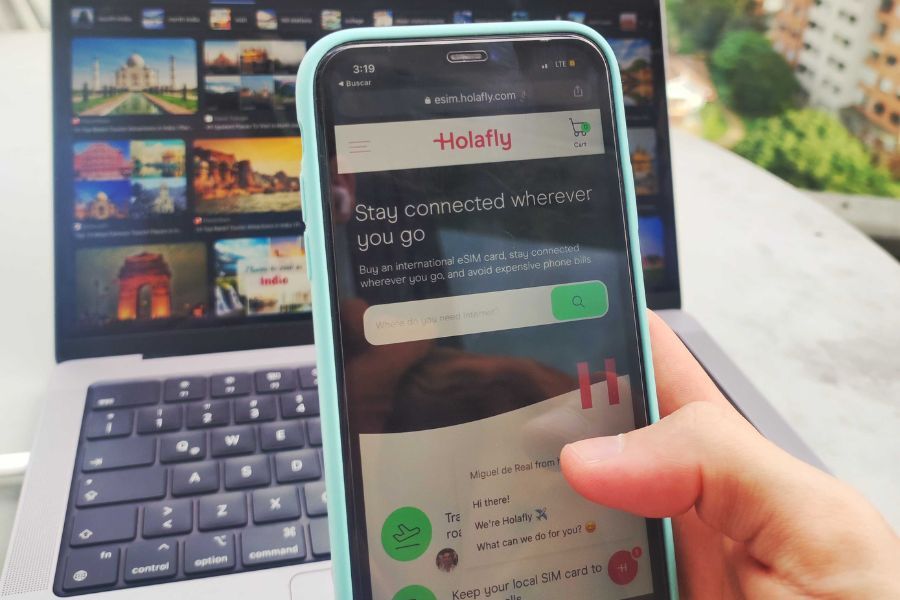
Drop me on a Balinese coastline with a decent paperback and my smartphone, and I’ll luxuriate for two weeks straight.
But fly me out to the same spot with a Nokia 3310 and a physical map, like the one my dad used to carry, and I’ll probably have a nervous breakdown.
Most of us can agree that we’re hyper-dependent on tech, especially when we’re navigating a new place abroad. And the further or more remote you go, the more likely you are to run into tech breakdowns that can put a damper on your plans to wander freely.
From racking up hidden costs to avoiding embarrassing gaffs, here are some of the top tech nightmares when traveling and how to avoid them on your next trip.
Free to roam… Or not
We’ve all been there. You forget yourself for one minute and enable your data to look something up: “best restaurants in Tel Aviv,” “fastest flight from Bangkok to Chiang Mai,” or “how to dress for Scottish weather.”
Join us at TNW Conference June 15 & 16 in Amsterdam
Get 20% off your ticket now! Limited time offer.
Five minutes later, you’ve racked up a hefty roaming charge. Ouch.
While some networks let you roam freely, others aren’t so generous. Before launching his alternative activewear brand, Rusty Martin spent some time travelling by skates. And subsequently paid a small fortune for it.
“I landed in Vancouver after an eight-hour flight and met some local in-line skaters,” Rusty tells me. “When I got back to my mate’s place, I had a bunch of notifications. I’d left my data on, and racked up about £70 in charges.”
Wait! It gets worse: “I didn’t pay the bill for over a year,” Rusty admits. “I was kinda like fuck the corporations, I don’t owe them. I didn’t even actively use my data, I’d just left it on. It all felt very unfair. But then they send debt collection agencies after you and ruin your credit rating.”
Always check your data plan (and your data settings), before you catch your flight. Or better yet, invest in a data plan that has your back.
Travel tech company Holafly eSIM provides eSIMs for people who want a steady and reliable connection without roaming charges. They offer regular data plans in over 130 countries, unlimited data plans in over 45 destinations, and even for entire regions like Europe. So, if you’re on a trip through Europe, instead of buying a plan for each country, you only will have to pay one time to get coverage in various countries. And because it’s a digital SIM, you can activate it in a matter of minutes by scanning the QR code sent to your email. Easy peasy.
Testing local limits
With internet censorship on the rise, don’t be surprised if your beloved apps and websites don’t work in other countries.
Srishti Verma got caught out in Vietnam when she was conducting research on reproductive health and rights for a non-profit based in Atlanta.
“The website loaded at first, but it didn’t work properly. The navigation was poor, things wouldn’t load, and it was affecting my research”, Srishti shares. “No access to related websites had me thinking something was wrong with my internet connection.”
Fortunately, Srishti’s pal reminded her to use a VPN, and all was not lost. But there are plenty of other countries where this solution would have fallen flat on its face. VPN bans and limitations are widespread in countries such as China, Turkey, and the UAE.
With a smartphone tucked neatly in our hands, it’s easy to forget not all countries have the same level of tech freedom.
All WiFi is good WiFi (just kidding!)
WiFi access is so ubiquitous that the thought of being without it is practically unbearable.
Michelle Coulson felt something similar on a recent trip to Portugal. As a digital nomad who helps people get remote jobs, her work was rudely interrupted by a lack of connectivity.
“We’d just gotten to a campsite and discovered there was no WiFi. We couldn’t find a shop open to get our mobile data topped up either — so we ended up driving miles to McDonald’s to use their crappy WiFi!”
At times like this, public WiFi is a godsend. But there’s a catch, often in the form of sacrificing a few personal details to log on. We all crave internet connection, but sometimes a public fix just isn’t worth the risk.
Crafty hackers can create doppelganger WiFi networks that look just like legitimate ones. So while you’re mindlessly scrolling, they’re scrounging for your account details. It’s an easy way to get your identity stolen — or the contents of your bank account.
You don’t even have to leave the airport to find trouble. According to a study by Forbes, 40% of respondents have had their data compromised while using public WiFi — with airport and restaurant WiFi posing the greatest threat.
If you’re using shared or public WiFi, find someone who can confirm you’re on the right network and call on your trusty VPN for an added layer of protection. Keep in mind that, if you’re connecting to a WiFi you don’t know, you also won’t know how they’re going to use the data collected during the session.
To ensure you have coverage without having to mess with dodgy free WiFi hotspots, check out Holafly’s guide to eSIMs.

Adaptors, voltages, and avoiding electrocution
No one wants to watch the light die on their phone screen before making it to the hotel. Forget your travel adaptors and this is the reality.
There are 15 electrical plug types, so make sure you find out which ones you’ll need for your destination country. Type C covers most of Europe (aside from the UK, Ireland, Cyprus, and Malta). But you’ll only get away with using type I plugs in Thailand.
Traversing multiple countries? Get yourself a universal adaptor. And try to find grounded ones — this will lower your risk of getting electrocuted if there’s an exposed wire in your gadget.
Most modern devices have variable voltage, so using them in a range of countries probably won’t get you fried. Gadgets that are designed to be portable — like smartphones, tablets, and laptops — usually have variable voltage. Shavers, hairdryers, and electric toothbrushes tend not to be, so make sure you check the specs on your devices before packing them.
Be prepared to power down
Was the sun just turned off forever? Or did you get caught in a power cut? I’m guessing the latter.
Power cuts will increase as the climate crisis worsens. And even paradise isn’t immune from a little lights-out action.
Georgie Darling is a digital nomad and travel writer who spent the first seven months of the pandemic stuck on the tiny Indonesian island of Gili Trawangan.
Due to the size and position of the island, Gili is prone to earthquakes and power cuts. Often at the same time.
“They were such a part of my daily life that the only reaction to the ground shaking was an ‘earthquake?’ message in our group chats,” Georgie shares.
“I got caught out a few times when client calls fell around the same time as the earthquakes and power cuts,” Georgie admits. “I quickly learned to keep my laptop and phone fully charged.”
For added protection, arm yourself with an eSIM (as mentioned above) and a couple of power banks. The Zendure Supermini is pocket size but packs a powerful punch. If you need something more heavy-duty, pick up the ZMI PowerPack 20000 — it’ll charge your phone and your laptop via a USB-C connection. And make sure you give clients and loved ones a heads-up about outages when possible.
“It made a good talking point with clients”, Georgie says. “Especially when I told them that the phrase for ‘power cut’ in Bahasa Indonesia is ‘mati lampu’, which directly translates to ‘death to the light.’”
Don’t get lost in translation
Where the risk of embarrassing yourself is low, translation apps can get you out of a pickle. Like checking the menu for meat-free options, or decoding the signs at a train station.
But bad translations can have awkward consequences. If you arrive in France and need a lawyer (un avocat), you could end up asking for an avocado instead (also un avocat). Oops.
Promising research on using Google translate in emergency departments showed that 82.5% of the translations retained their meaning. But results vary significantly between languages, which is a problem if you have sensitive information to share.
The best way to avoid translation app fails is to use them cautiously. Don’t count on them saving your bacon every time — and do some practice on Duolingo before you jet off.
So if you’re not quite ready to trade your smartphone in for a map book, don’t forget to pack your virtual suitcase before setting out on your next globetrotting adventure. Handy travel tech tools like an international eSim, VPNs, and portable power banks will make all the difference when you’re trapped in paradise without a connection (your Insta followers and mom will thank you).







